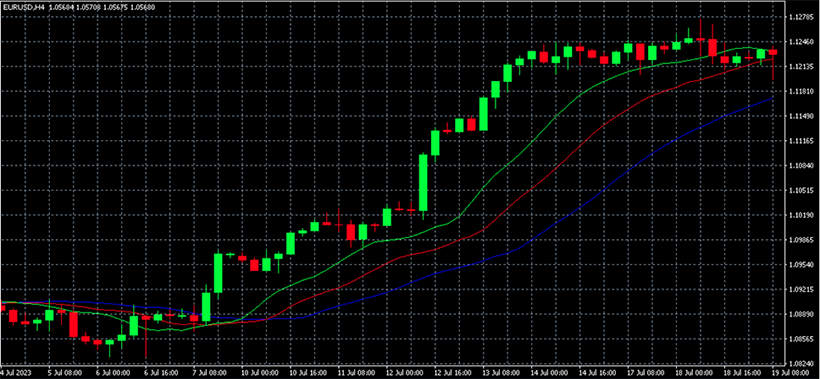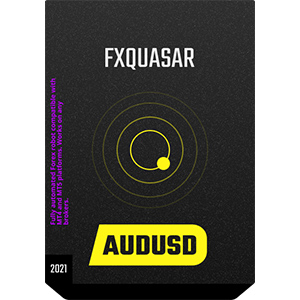
Erfahrene Händler wissen um die Bedeutung zuverlässiger technischer Indikatoren. Sie leiten unsere Handelsentscheidungen und helfen uns, Verluste zu vermeiden. Eines der beliebten Tools, über das wir in diesem Artikel sprechen werden, ist der Alligator-Indikator von Williams. Er wurde unter der Annahme geschaffen, dass der Markt die meiste Zeit nicht vorankommt. Deshalb ist ein klares Verständnis, wann ein neuer Trend entsteht, entscheidend. Unter solchen Umständen kann der Alligator sehr nützlich sein. In diesem Leitfaden werden wir besprechen, wie man den Alligator-Indikator verwendet, seine Herkunft, Komponenten, Vorteile und potenzielle Nachteile.
Was ist der Alligator-Indikator?
Das Tool wurde erstmals von Bill Williams im Jahr 1995 beschrieben. Es ist ziemlich beliebt und ist in den Analysepaketen der meisten Terminals enthalten. Sie können es leicht auf MT4, MT5 und anderen beliebten Plattformen finden. Trotz seiner Einfachheit hat es bestimmte Fallstricke und ein großes Potenzial für Händler.
Komponenten des Alligator-Indikators

Der Indikator besteht aus drei Kurven (gleitenden Durchschnitten) mit spezifischen Einstellungen. Laut Bill Williams sagen der ursprüngliche Versatz und die Perioden am besten die Richtung des zukünftigen Trends voraus. Sie können ihn auf dem Chart mit den Grund-einstellungen anzeigen oder gemäß Ihrer Alligator-Handelsstrategie anpassen. Hier sind die Standard-einstellungen der MAs:
- Die grüne Linie (Alligator-Lippen): Periode 5. Verschoben um 3 Perioden.
- Die rote Linie (Alligator-Zähne): Periode 8. Verschoben um 5 Perioden.
- Die blaue Linie (Alligator-Kiefer): Periode 13. Verschoben um 8 Perioden.
Es ist gut zu erkennen, dass der grüne MA der schnellste ist und als Erstes auf den Markt reagiert. Nun wollen wir uns die Komponenten des Alligator-Indikators genauer ansehen.
Der Kiefer (blaue Linie)
Der blaue MA (Alligator-Kiefer) ist der 13-Perioden gleitende Durchschnitt, der um 8 Balken nach vorne verschoben ist. Dies ist die letzte Linie, die sich zu bewegen beginnt. Wenn sie sich vom Preisdiagramm abweicht, gewinnt der Trend wahrscheinlich bereits an Stärke.
Die Zähne (rote Linie)
Der rote MA (Alligator-Zähne) ist der 8-Perioden geglättete MA mit einer 5-Balken-Verschiebung in die Zukunft. Es handelt sich um eine sensiblere Linie, die daher früher als der Kiefer abweicht.
Die Lippen (grüne Linie)
Der letzte MA (Alligator-Lippen) ist grün. Die Periode beträgt 5 und die Verschiebung beträgt 3 Balken. Dies ist der sensibelste gleitende Durchschnitt, der den Händlern das erste Signal gibt.
Zweck und Theorie hinter dem Alligator-Indikator
Der William Alligator-Indikator erhielt seinen Namen aufgrund einer gewissen Ähnlichkeit mit dem Raubtier. Drei gleitende Durchschnitte bilden eine Form, die einem Alligator mit geschlossenem, leicht geöffnetem oder geöffnetem Mund ähnelt. Diese lebendige Metapher gibt uns ein klares Verständnis für die Stimmung und Absichten des Alligators.
Wenn Sie sich die drei geglätteten MAs ansehen, können Sie den Mund oder Kiefer des Alligators sehen. Normalerweise ist dies als blaue Linie markiert. Der schneller gleitende Durchschnitt (die Zähne) hat eine Periode von 8 und ist um 5 Balken in die Zukunft verschoben. Er ist rot. Die kürzeste und schnellste Linie wird als Alligator-Lippen bezeichnet. Sie ist grün. Zusammen zeigen diese drei Linien perfekt den metaphorischen Charakter des Alligators und bestimmen die Bewegungen des Marktes in naher Zukunft.
Wie der Alligator-Indikator funktioniert

Lassen Sie uns den Alligator-Indikator mit der Metapher erklären. Wenn der Alligator satt ist, ignoriert er die aktuellen Marktbedingungen. Zu dieser Zeit sind die gleitenden Durchschnitte miteinander verflochten, sodass es schwer ist, sie zu unterscheiden. Während der Ruhezeit des Alligators ist der seitliche Trend der häufigste Zustand des Marktes.
Wie werden wir erkennen, dass das Krokodil hungert? Wenn es anfängt zu jagen, öffnet sich sein Maul. Die Kiefer spreizen sich, die Zähne werden sichtbar und die Lippen beginnen sich zu bewegen, um Nahrung zu fangen. Auf dem Preisdiagramm überwachen wir die Divergenz der drei gleitenden Durchschnitte. Die Reihenfolge ihres Erwachens ist wie folgt: die Lippen (grüne Linie), die Zähne (rote Linie) und der Kiefer (blaue Linie). Der MA mit der längsten Periode (13 Balken) ist der langsamste.
Je hungriger das Krokodil wird, desto weiter öffnet sich sein Maul. Dies deutet auf einen Trend hin. Die Linien divergieren und der Kiefer entfernt sich weiter von der Preisentwicklung. Das Ende des Trends hat eine gegenteilige Darstellung auf dem Diagramm. Die Linien nähern sich einander und beginnen sich zu verflechten. Das Maul schließt sich, und das Krokodil wartet auf die nächste Jagd (Trend) Zeit.
Berechnung des Alligator-Indikators
MetaTrader 4 und andere Handelsplattformen verwenden einfache Formeln zur Berechnung des Alligator-Indikators. Im Allgemeinen berechnen sie drei MAs mit den festgelegten Perioden und Verschiebungen. Um dies manuell zu tun, sollten Sie zunächst den Medianpreis jeder Leiste bestimmen:
Medianpreis = (Hoch + Tief)/2.
Der nächste Schritt ist die Berechnung der Linien:
Kiefer = Geglätteter gleitender Durchschnitt (Medianpreis, 13, 8).
Zähne = Geglätteter gleitender Durchschnitt (Medianpreis, 8, 5).
Lippen = Geglätteter gleitender Durchschnitt (Medianpreis, 5, 3).
Die zweite Ziffer in Klammern gibt die Periode an, und die dritte Ziffer ― die Verschiebung. Sie können die Linien manuell erstellen oder spezielle Software verwenden. Wenn Sie die zweite Option wählen, müssen Sie den Indikator im Menü finden und die Eingabedaten festlegen.
Wie man den Alligator-Indikator liest und interpretiert
Die Frage "Wie liest man den Alligator-Indikator?" ist nicht so schwer. Die Einfachheit macht ihn zu einem der beliebtesten Werkzeuge unter den Forex-Teilnehmern. Hier sind die Hauptmuster, die Sie auf dem Diagramm sehen können:
- Die grüne MA ist höher als die rote MA, und die rote MA ist höher als die blaue MA. Sie sind alle nach oben gerichtet. Dies ist ein Zeichen für einen expandierenden Markt. Wahrscheinlich ist es eine gute Zeit, Long-Positionen zu eröffnen.
- Die grüne Linie liegt unter der roten Linie, und die rote Linie liegt unter der blauen Linie, während sie alle nach unten gerichtet sind. Dieses Muster deutet auf einen bärischen Trend hin. Wahrscheinlich können Sie selbstbewusst eine Short-Position eröffnen.
- Die Linien sind miteinander verflochten oder nähern sich einander an. Dies ist eine Phase der Seitwärtsbewegung, und es ist besser, mit dem Handel zu pausieren und auf das Signal zu warten.
- Die Divergenz zwischen den Linien nimmt zu. Dies deutet auf die Stärkung des Trends hin.
Sie sollten auch wissen, dass je länger ein Alligator schläft, desto hungriger wird er, und der zukünftige Trend kann stärker sein.
Handelsstrategien mit dem Alligator-Indikator
Es gibt keine einheitliche Williams-Alligator-Handelsstrategie. Sie können das Tool für verschiedene Zwecke nutzen und mit anderen Instrumenten kombinieren. Sie können jedoch diese Ansätze ausprobieren:
- Range-Trading. Sie können innerhalb des vom Alligator angezeigten bestimmten Bereichs handeln.
- Breakout-Trading. Die gängige Strategie, wenn der Preis den Bereich durchbricht.
- Rollbacks verwenden. Sie eröffnen eine neue Position in der Nähe der vorherigen.
- Crossover finden. Wenn die Leiste unter oder über den drei Linien schließt, können Sie in den Markt eintreten.
Eine effektive Alligator-Strategie im Forex-Bereich kann entwickelt werden, wenn Sie das Verhalten des Indikators genau beobachten, verschiedene Zeiträume überprüfen und zusätzliche Bestätigungen erhalten. Es wird sich kontinuierlich verbessern, wenn Sie sich voll und ganz dieser Methode verpflichten.
Die besten Einstellungen für den Alligator-Indikator
Der Alligator-Indikator wird im Preisdiagramm durch drei gleitende Durchschnitte angezeigt, die bestimmte Perioden und Verschiebungen haben. Sie haben in der Regel Standardwerte. Die blaue Linie hat eine Periode von 13 und eine Verschiebung von 8. Die rote Linie hat eine Periode von 8 und eine Verschiebung von 5. Die grüne Linie hat eine Periode von 5 und eine Verschiebung von 3. Je nach Ihren Vorlieben können sie leicht erhöht oder verringert werden.
Der nächste wichtige Faktor ist der Zeitrahmen. Es ist am besten, mit dem Alligator-Indikator auf H24-Charts und höher zu handeln. Obwohl er theoretisch auf allen Zeitrahmen funktioniert, wird nicht empfohlen, unter H4 oder zumindest H1 zu gehen. Auf den kürzeren Zeiträumen wird der Indikator viele falsche Signale liefern.
Vorteile und Einschränkungen des Alligator-Indikators
Händler können durch die Verwendung des Williams Alligator-Indikators mehrere Vorteile erzielen. Hier sind die wichtigsten Vorteile, die Ihre Aufmerksamkeit wert sind:
- Er bietet eine klare visuelle Darstellung der Markttrends und erleichtert das Erkennen potenzieller Umkehrungen.
- Das Tool eliminiert kurzfristige Schwankungen und hilft, starke Trends zu identifizieren.
- Es gibt einfache Regeln, wann man in den Markt einsteigen oder die Position halten soll.
Sicherlich ist dies kein perfekter Indikator und er hat seine Einschränkungen. Zum Beispiel kann er nicht während der seitlichen Bewegung verwendet werden. Er ist auch in den kurzen Zeitrahmen unwirksam. Trotz dieser Tatsache ist der Williams-Alligator immer noch ein nützliches und verbreitetes technisches Werkzeug.
Verwendung des Alligator-Indikators im Forex-Handel
Jetzt, da Sie die allgemeinen Prinzipien des Tools kennen, ist es an der Zeit zu verstehen, wie man den Alligator-Indikator im Forex-Handel einsetzt. Hier sind einige zusätzliche Tipps, die Ihnen helfen, das hungrige Raubtier in Ihre Strategie zu integrieren:
- Verfolgen Sie mehrere Zeiträume. Dies wird es Ihnen ermöglichen, einen breiteren Blick auf den Markt zu gewinnen.
- Berücksichtigen Sie die Marktbedingungen. Erkunden Sie die aktuelle Stimmung und andere Faktoren.
- Kombinieren Sie es mit anderen Indikatoren. Es ist immer nützlich, weitere technische Tools für präzisere Entscheidungen zu verwenden.
- Studieren Sie den Indikator und seine Korrelation mit dem Preis ständig. Auf verschiedenen Währungspaaren kann er unterschiedlich funktionieren.
Zu guter Letzt: Konsequenz und Disziplin sind Schlüssel zum Meistern eines jeden technischen Indikators. Machen Sie weiter, um Ihre Leistung zu verbessern.
Das Fazit
Viele erfahrene Händler betrachten den Forex-Indikator Alligator als ein wichtiges Instrument in ihrem Handelswerkzeugkasten. Er hilft, Trendumkehrungen mit hoher Genauigkeit zu identifizieren und die Handelsergebnisse zu verbessern. Sie können noch mehr Gewinn erzielen, wenn Sie den Indikator mit Automatisierungstools wie den besten Forex-Robotern kombinieren. Verwenden Sie sie, um manuelle Arbeit zu vermeiden und genauere Entscheidungen zu treffen.









